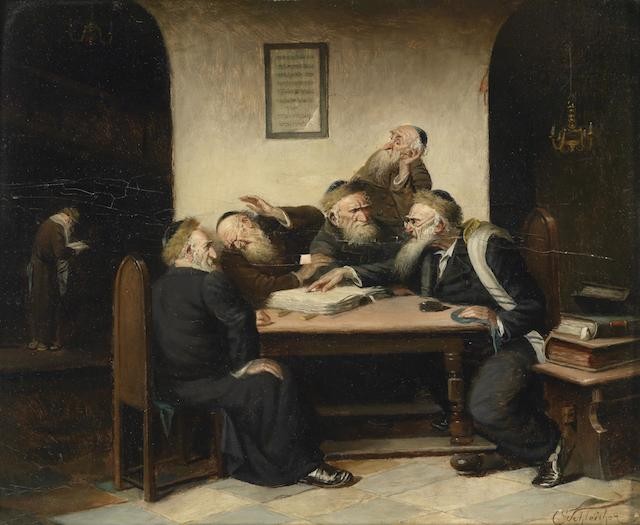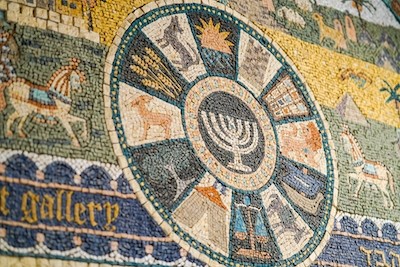What Is Talmud? It’s a central text of Rabbinic Judaism and a cornerstone of Jewish law, thought, and culture, demanding exploration. WHAT.EDU.VN offers simple explanations to navigate this complexity. Delve into the wisdom of the Talmudic literature, understanding its impact and continuing relevance, and unlock answers related to Jewish scholarship and legal discussions.
1. Understanding the Core of Talmud
The Talmud, meaning “study” or “learning,” isn’t just one book, it’s a collection of writings that delve into Jewish law, ethics, customs, and history. It serves as a record of rabbinic discussions and debates pertaining to Jewish law, theology, and philosophy. To truly understand what the Talmud is, it’s necessary to break down its components and understand its historical context.
1.1. The Mishnah: The Foundation
The Mishnah is the first major written collection of Jewish oral traditions, also known as the Oral Torah. Compiled around 200 CE by Rabbi Judah the Prince, the Mishnah organizes Jewish law into six orders (sedarim), each further divided into tractates (massechtot):
- Zeraim (Seeds): Deals with agricultural laws and blessings.
- Moed (Festival): Focuses on the laws of the Sabbath and festivals.
- Nashim (Women): Addresses laws related to marriage, divorce, and family.
- Nezikin (Damages): Covers civil and criminal law.
- Kodashim (Holy Things): Deals with laws of sacrifices and the Temple.
- Tohorot (Purities): Focuses on laws of ritual purity.
The Mishnah serves as the bedrock upon which the rest of the Talmud is built. It presents legal opinions and disputes among the rabbis, without always providing definitive rulings. This is where the Gemara comes in.
1.2. The Gemara: Elaboration and Debate
The Gemara (meaning “completion” or “learning”) is a rabbinical commentary on the Mishnah. It expands upon the Mishnah’s terse statements, providing reasoning, analysis, and debate. The Gemara seeks to understand the underlying principles of the Mishnah and to apply those principles to new situations.
Different communities developed their own Gemara, leading to two versions of the Talmud:
- Talmud Yerushalmi (Jerusalem Talmud): Compiled in the Land of Israel around the 4th century CE.
- Talmud Bavli (Babylonian Talmud): Compiled in Babylonia (modern-day Iraq) around the 6th century CE.
The Babylonian Talmud is more extensive and authoritative than the Jerusalem Talmud and is the primary focus of Talmud study today.
**1.3. Understanding the Structure: Mishnah and Gemara Together
The Talmud consists of the Mishnah text followed by the Gemara’s analysis and discussion. Imagine the Mishnah as a legal code, and the Gemara as the case law, arguments, and scholarly interpretations that clarify and apply that code. A single page of Talmud will typically include the Mishnah text in the center, surrounded by commentary from the Gemara.
2. Historical Development of the Talmud
Understanding the history of the Talmud is crucial to understanding its content and significance. The Talmud didn’t spring into existence overnight. It was the result of centuries of oral transmission, rabbinic debate, and ultimately, written compilation.
2.1. The Oral Torah: From Tradition to Writing
Jewish tradition holds that along with the Written Torah (the Five Books of Moses), God also revealed an Oral Torah, which was passed down through generations. This Oral Torah consisted of interpretations, explanations, and legal rulings that were not explicitly written in the Torah itself.
Over time, as the Jewish people faced increasing challenges and dispersion, there was a concern that the Oral Torah might be forgotten. This led to the decision to begin writing it down, culminating in the Mishnah.
2.2. The Amoraic Period: Gemara’s Genesis
Following the compilation of the Mishnah, the period of the Amoraim (“expounders”) began. These rabbis, based in both the Land of Israel and Babylonia, devoted themselves to studying and interpreting the Mishnah. Their discussions, debates, and analyses form the basis of the Gemara.
The Gemara isn’t a unified, monolithic work. It reflects the diverse opinions and approaches of different rabbis and academies.
2.3. Saboraim and Geonim: Shaping the Talmud
After the Amoraic period, the Saboraim (“reasoners”) and Geonim (“excellencies”) continued the work of shaping and editing the Talmud. They added further commentary and clarification, and ultimately finalized the text of the Babylonian Talmud.
2.4. The Talmud Through the Ages: Commentary and Interpretation
The Talmud didn’t stop evolving with its initial compilation. Throughout history, countless scholars have written commentaries on the Talmud, seeking to explain its meaning and apply its teachings to new situations.
Some of the most important commentaries include:
- Rashi (Rabbi Shlomo Yitzchaki): His commentary provides a clear and concise explanation of the Talmud’s plain meaning.
- Tosafot: These commentaries, written by a group of medieval scholars, offer more in-depth analysis and alternative interpretations.
3. Key Concepts in Talmudic Study
Studying the Talmud can seem daunting at first. It’s a complex and multifaceted text that requires patience, dedication, and a willingness to grapple with difficult ideas. However, understanding some key concepts can make the process more accessible.
3.1. Halakha and Aggadah: Law and Narrative
The Talmud contains two main types of material:
- Halakha: This refers to legal material, including laws, rules, and procedures.
- Aggadah: This refers to narrative material, including stories, legends, parables, and ethical teachings.
While Halakha focuses on practical application, Aggadah provides context, inspiration, and moral lessons.
3.2. Pilpul: Sharp Reasoning and Debate
Pilpul refers to a method of Talmudic study that involves intense logical analysis and debate. It seeks to uncover hidden assumptions, identify contradictions, and explore alternative interpretations.
While sometimes criticized for being overly complex, Pilpul plays a vital role in sharpening the mind and deepening understanding of the Talmud.
3.3. Midrash: Biblical Interpretation
The Talmud often draws upon the Hebrew Bible (Tanakh) to support its legal and ethical teachings. Midrash refers to the process of interpreting biblical texts, often finding deeper meanings and connections than are immediately apparent.
3.4. Case-Based Reasoning: Learning from Examples
The Talmud often presents legal principles in the context of specific cases. By analyzing these cases, students can learn how to apply the law to different situations. This case-based approach encourages critical thinking and problem-solving.
4. Why Study the Talmud? Its Significance and Relevance
The Talmud has been a central text in Jewish life for centuries. It has shaped Jewish law, thought, and culture. But why should anyone study the Talmud today?
4.1. A Source of Jewish Law and Ethics
The Talmud is a primary source of Jewish law (Halakha). It provides guidance on a wide range of issues, from ritual observance to business ethics. Even today, rabbis and legal scholars turn to the Talmud to resolve contemporary legal questions.
4.2. A Window into Jewish History and Culture
The Talmud offers a glimpse into the lives and minds of the rabbis who shaped Jewish history. It reflects the social, economic, and political realities of their time. By studying the Talmud, we can gain a deeper understanding of Jewish history and culture.
4.3. A Tool for Intellectual and Spiritual Growth
Studying the Talmud challenges the mind and stimulates critical thinking. It requires patience, perseverance, and a willingness to grapple with complex ideas. It also encourages ethical reflection and spiritual growth.
4.4. Connecting to a Chain of Tradition
By studying the Talmud, we connect ourselves to a long chain of Jewish tradition. We join the generations of scholars who have wrestled with these texts and found meaning in them.
5. Addressing Common Misconceptions About the Talmud
The Talmud is often misunderstood, both by those outside the Jewish community and even by some within it. It’s important to address some common misconceptions.
5.1. Is the Talmud More Important Than the Torah?
No. Jewish tradition considers the Torah to be the word of God, while the Talmud is a human interpretation of the Torah. However, the Talmud is essential for understanding how to apply the Torah’s teachings to daily life.
5.2. Is the Talmud Secret or Esoteric?
While the Talmud is complex and requires dedicated study, it’s not a secret or esoteric text. It’s widely available in libraries and online. However, proper guidance and instruction are essential for understanding it.
5.3. Does the Talmud Promote Hatred or Discrimination?
This is a harmful and false accusation. While the Talmud contains some passages that may be interpreted as negative towards non-Jews, these passages must be understood in their historical context and within the framework of Jewish ethics. The overwhelming message of the Talmud is one of compassion, justice, and respect for all human beings.
5.4. Is the Talmud Unchanging and Rigid?
No. While the text of the Talmud remains fixed, its interpretation and application continue to evolve. Contemporary scholars grapple with the Talmud’s teachings in light of modern challenges and values.
6. Resources for Learning Talmud
Interested in learning more about the Talmud? There are many resources available, both online and in person.
6.1. Online Resources
- Sefaria: A free online library of Jewish texts, including the Talmud, with translations and commentaries.
- My Jewish Learning: Offers articles and resources on various aspects of Judaism, including the Talmud.
- Daf Yomi: A program of reading one page of Talmud each day, completing the entire Talmud in about seven and a half years. Many online resources support Daf Yomi learners.
6.2. Books and Commentaries
- The Schottenstein Edition of the Talmud: A popular English translation and commentary.
- The ArtScroll Tanach Series: Provides translations and commentaries on the Hebrew Bible, which is essential for understanding the Talmud.
- Introduction to the Talmud and Midrash by Hermann L. Strack and Günter Stemberger: A classic academic introduction to the Talmud.
6.3. Classes and Study Groups
Many synagogues, Jewish community centers, and universities offer classes and study groups on the Talmud. These can provide valuable guidance and support.
7. Talmudic Literature and Its Influence
The Talmud is not an isolated text. It exists within a broader context of rabbinic literature, and it has had a profound influence on Jewish thought and culture.
7.1. Related Rabbinic Texts
- Tosefta: A collection of Tannaitic (Mishnaic period) teachings that did not make it into the Mishnah. It often provides alternative versions of Mishnaic laws or expands on them.
- Midrash Rabbah: A collection of homiletical midrashim (interpretations) on the books of the Torah and the Five Megillot (Scrolls).
- Mishneh Torah (by Maimonides): A comprehensive code of Jewish law based on the Talmud, organized by topic.
- Shulchan Aruch (by Joseph Karo): Another influential code of Jewish law, which became the standard reference for practical halakha.
7.2. Influence on Jewish Thought and Culture
- Jewish Law: The Talmud is the primary source of Jewish law, guiding Jewish practice in all areas of life.
- Jewish Ethics: The Aggadic sections of the Talmud provide ethical and moral guidance, shaping Jewish values and behavior.
- Jewish Philosophy: The Talmud has influenced Jewish philosophical thought, particularly in the areas of ethics, theology, and metaphysics.
- Jewish Literature: The Talmud has inspired countless works of Jewish literature, including poetry, fiction, and drama.
8. The Language of the Talmud
The Talmud is written primarily in two languages: Mishnaic Hebrew and Aramaic. Understanding these languages, or having access to reliable translations, is essential for studying the Talmud.
8.1. Mishnaic Hebrew
Mishnaic Hebrew is a form of Hebrew that was spoken in the Land of Israel during the Mishnaic period (approximately 200 BCE to 200 CE). It differs from Biblical Hebrew in its vocabulary, grammar, and style.
8.2. Aramaic
Aramaic was the common language of the Near East during the Talmudic period. The Babylonian Gemara is written primarily in Babylonian Aramaic, while the Jerusalem Gemara is written in a different dialect of Aramaic.
8.3. The Importance of Translation
For those who do not know Hebrew or Aramaic, reliable translations are essential for studying the Talmud. However, it’s important to be aware that translation is always an act of interpretation, and different translations may reflect different perspectives.
9. Contemporary Approaches to Talmud Study
While traditional methods of Talmud study remain important, contemporary scholars have also developed new approaches to understanding the Talmud.
9.1. Academic Approaches
Academic scholars apply the tools of literary criticism, historical analysis, and social science to the study of the Talmud. They seek to understand the Talmud in its historical and cultural context, and to identify the sources and influences that shaped it.
9.2. Feminist Approaches
Feminist scholars examine the Talmud from a feminist perspective, exploring the roles and experiences of women in the Talmudic world. They also challenge traditional interpretations that may be biased against women.
9.3. Interdisciplinary Approaches
Some scholars are exploring the connections between the Talmud and other fields of study, such as law, philosophy, and literature. These interdisciplinary approaches can shed new light on the Talmud and its relevance to contemporary issues.
10. Frequently Asked Questions About the Talmud
Here are some frequently asked questions about the Talmud:
| Question | Answer |
|---|---|
| What is the difference between the Mishnah and the Gemara? | The Mishnah is the first written collection of Jewish oral traditions, while the Gemara is a rabbinical commentary on the Mishnah. |
| Which Talmud is more authoritative? | The Babylonian Talmud (Talmud Bavli) is generally considered more authoritative than the Jerusalem Talmud (Talmud Yerushalmi). |
| What languages is the Talmud written in? | The Talmud is written primarily in Mishnaic Hebrew and Aramaic. |
| Is the Talmud difficult to study? | Yes, the Talmud is a complex text that requires dedicated study and proper guidance. |
| Where can I find resources for learning Talmud? | There are many online resources, books, and classes available. Sefaria, My Jewish Learning, and local synagogues or Jewish community centers are good places to start. |
| What are some common misconceptions about the Talmud? | Some common misconceptions include the idea that the Talmud is more important than the Torah, that it is secret or esoteric, or that it promotes hatred or discrimination. |
| What is Halakha? | Halakha refers to Jewish law, which is largely based on the Talmud. |
| What is Aggadah? | Aggadah refers to the narrative and ethical material in the Talmud, including stories, legends, and parables. |
| Why study the Talmud? | Studying the Talmud can provide a deeper understanding of Jewish law, history, and culture, and can also stimulate intellectual and spiritual growth. |
| How has Talmud influenced Jewish culture? | The Talmud has shaped Jewish law, ethics, philosophy, literature, and art. It is a central text in Jewish life and continues to influence Jewish thought and practice today. |



Studying the Talmud can be a rewarding and enriching experience. It offers a window into the minds of the rabbis who shaped Jewish history and provides guidance on how to live a meaningful and ethical life.
Navigating the complexities of the Talmud can seem daunting, but WHAT.EDU.VN is here to help. We provide clear, concise answers to your questions, making even the most challenging topics accessible.
Don’t let your curiosity go unanswered. Whether you’re grappling with a specific passage or seeking a broader understanding of Jewish thought, WHAT.EDU.VN offers a free platform to explore your questions. Our community of experts is ready to provide insightful answers and guide you on your learning journey.
Ready to unlock the wisdom of the Talmud?
Visit WHAT.EDU.VN today and ask your question for free. Our services are available to anyone, regardless of background or knowledge level. We’re committed to providing accessible and reliable information to help you learn and grow.
Have a question about Jewish law, ethics, or history?
Our team of experts is here to help you find the answers you need. Don’t hesitate to reach out and let us guide you on your path to knowledge.
Contact us:
Address: 888 Question City Plaza, Seattle, WA 98101, United States
Whatsapp: +1 (206) 555-7890
Website: WHAT.EDU.VN
Ask your question on what.edu.vn today and discover the answers you’ve been searching for. Let us help you explore the fascinating world of knowledge.